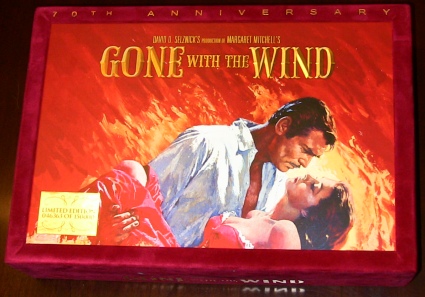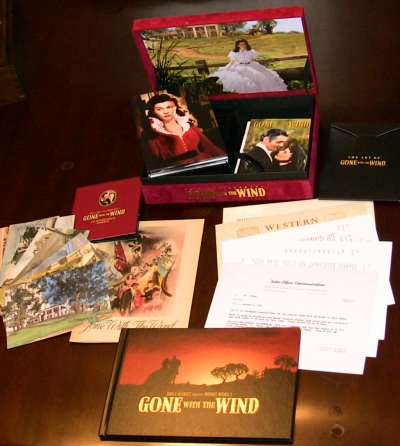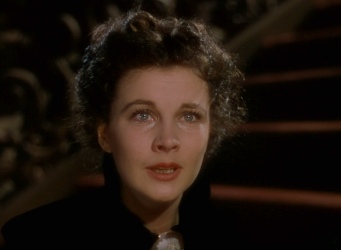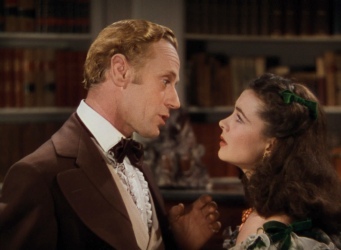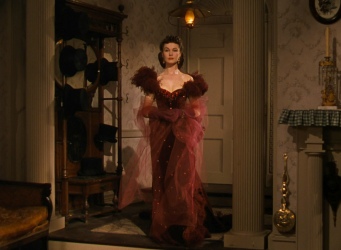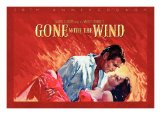| Reviews & Columns |
|
Reviews DVD TV on DVD Blu-ray 4K UHD International DVDs In Theaters Reviews by Studio Video Games Features Collector Series DVDs Easter Egg Database Interviews DVD Talk Radio Feature Articles Columns Anime Talk DVD Savant Horror DVDs The M.O.D. Squad Art House HD Talk Silent DVD
|
DVD Talk Forum |
|
|
| Resources |
|
DVD Price Search Customer Service #'s RCE Info Links |
|
Columns
|
|
|
Gone with the Wind
Warner Bros. // G // November 17, 2009 // Region 0
List Price: $84.99 [Buy now and save at Amazon]
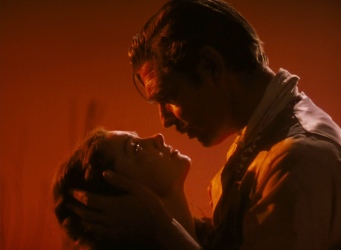 |
| [click on the thumbnail to enlarge] |
There was a land of Cavaliers and Cotton Fields called the Old South. Here in this pretty world, Gallantry took its last bow. Here was the last ever to be seen of Knights and their Ladies Fair, of Master and of Slave. Look for it only in books, for it is no more than a dream remembered, a Civilization gone with the wind...
The Old South may be a distant memory, but Gone with the Wind continues to endure. Margaret Mitchell's novel has sold some 30 million copies since its initial release in 1936, and several of the sequels it inspired went on to become bestsellers themselves. The film adaptation that soon followed continues to hold the record for the most box office admissions of all time, and between its many successful re-releases over the past seven decades, its tally adjusted for inflation approaches one and a half billion dollars. Gone with the Wind has been released on DVD no fewer than five times as I write this, and what better way for Warner Bros. to celebrate the film's seventieth anniversary than with this spectacular collectors' edition on Blu-ray?
Teenaged Scarlett O'Hara (Vivien Leigh) doesn't have a care in the world, and she can afford not to; her father (Thomas Mitchell) is an Irish immigrant with a profound love for the land, and he's parlayed that passion into a fortune. Scarlett is able to freewheelingly galavant around Tara, the family's sprawling plantation, with a battalion of slaves working the land and catering to her every whim. Seemingly every man from one end of Georgia to the other is hopelessly enthralled with her, but Scarlett can barely be bothered to pay attention. Her eyes are aimed squarely at Ashley Wilkes (Leslie Howard), if only because his attention has been directed elsewhere. Scarlett is hellbent on snatching Ashley away from wedding his sweetly demure cousin Melanie (Olivia de Havilland), and with the announcement to be made at a party at the Wilkes' Twelve Oaks estate the following day, she'll have to make quick work of it. Scarlett had long since grown weary from all this talk of war, and yet it remains the dominant topic of conversation at the Wilkes' barbecue. Most look at it as a matter of pride. After all, these are gentlemen, and they feel as if they've been wronged. Let the North march down to the Confederate borders; they'll be crossing back over the Mason-Dixon line with their tails tucked between their legs inside a couple of weeks. One of the partygoers doesn't let himself get swept up in this fervor, though. Arrogant boasting hasn't won all that many wars, after all, and the North is much better equipped. Everyone shrugs off this interloper from Charleston, Rhett Butler (Clark Gable). His swaggering charm might be able to effortlessly win over the fairer sex, but the men...? No. They have their chests puffed out and are ready to fight, and once this little spat is over, the longevity of the Confederacy will be assured and they can all go back to sipping their mint juleps.
He was right. The Old South is quickly reduced to smoldering cinders. Far too many of her sons are dead or sprawled out across a dirt road in Atlanta with the rest of the wounded. The former slaves have either joined the war effort or fled, and the plantations and cotton fields have been burnt to the ground. There's no more money, there are barely any munitions, and even something as simple and primal as food seems to be a hazy memory. Virtually every able-bodied man is still struggling against the forces of the North, leaving the women and the infirmed to fend for themselves back home. The first half of Gone with the Wind focuses on the ravages of war on the homefront. Scarlett is no longer the naive and...well, innocent isn't quite the word...girl she was in sunnier days. With Melanie, she toils away as a nurse but relents as the savagery of conflict surrounds her. After being charged to assist as a man's leg is amputated with all forms of anaesthesia long since exhausted, Scarlett can take it no longer. She stays only long enough to deliver Melanie's child, but Atlanta is a lost cause. As the Confederacy torches their own munitions, Scarlett makes her escape with Rhett, braving an almost feral city in its death throes with her squeaky-voiced slave Prissy (Butterfly McQueen), a devastatingly weak Melanie, and the newborn baby. Rhett offers to spirit her far away -- Mexico? Europe? -- but Scarlett insists on returning home to Tara.
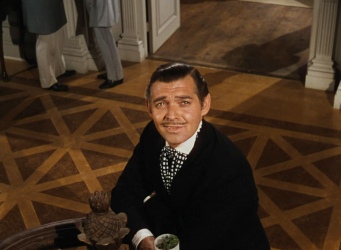 |
| [click on the thumbnail to enlarge] |
David O. Selznick slaved over the screenplay for Gone with the Wind, hiring numerous writers to adapt Margaret Mitchell's gargantuan novel -- F. Scott Fitzgerald among them -- and churning through so many drafts that there never was a definitive shooting script. I never would've guessed. What continues to marvel me about Gone with the Wind is how it's so deftly able to convey such a sprawling, epic scope without losing sight of the intimate drama between its characters. A lesser film would've leaned on the sheer spectacle as a crutch; Selznick, meanwhile, views it as a means to an end...to inform the gravity of the story being told here. Despite the daunting four hour length of this cut of the film, the storytelling and its richly-drawn characters are so unrelentingly engaging that it feels as if Gone with the Wind unspools for just a fraction of that runtime. Its dialogue may also be the most eminently quotable of any single film released before Casablanca, and Gone with the Wind is, of course, flawlessly cast.
The American public took it for granted that Clark Gable would star as Rhett Butler, and they were wholly correct: he does a marvelous job in the part. It's impossible not to be bowled over by Rhett's quick wit and confident charm, and despite his vocal disinterest in the war, he's easily the most heroic of its male characters. What sets Rhett apart from the more respectable Southern gentlemen pictured here is that they march in lockstep with what's expected of them. When they talk about defending the honor of the South, I can't shake the impression that they haven't invested any real thought into the war that stands before them. They're simply playing their part...doing what they think they're supposed to do. Rhett, meanwhile, is guided by his own compass. Yes, he's frequently driven by pleasures financial and physical. His closest confidante, after all, is the madam of a nearby brothel. This does little to change the fact that Rhett more than any other man in the film follows through with what he believes to be right, putting himself at great risk along the way. He's the one man in the movie where there's no doubt that he'll go to whatever lengths necessary to protect the people he cares about, and he'll undoubtedly come out on top. Rhett may be a cad with a strong self-serving streak, but he's a great man just the same. For much of the film, Gone with the Wind features the character somewhat sparingly, ensuring that each appearance provides the greatest possible impact.
Rhett is told early on that "you, sir, are no gentleman." With a smirk, he replies to Scarlett "...and you're no lady", and he's not wrong. Scarlett follows a wholly convincing trajectory as a character. At the outset, she's a scheming, calculating, and manipulative child. Men are there for her convenience...to cater to her whims. Everyday life is just an excuse to don another from a parade of breathtakingly gorgeous dresses and be doted on some more. A certain strength and tenacity had long simmered inside her, and it isn't until war breaks out that it's brought to a full boil. Scarlett periodically buckles under the pressure, yes, but she generally accepts the responsibilities she's been handed. She takes the reins because that's simply the only way to survive. There's no longer anyone else for her to rely on, and the dainty, silky soft hands of a Southern belle are soon caked in the blood of the sons of the South and calloused from fieldwork. Scarlett has certainly hardened and has been forced to draw from a reserve of strength she never knew she had, but it's debatable just how much she's actually matured. After all, this is a woman who once wed for petty revenge and marries again for financial security. It's a means to an end. Scarlett after the war is as manipulative as she ever was and doesn't hesitate to lay a guilt trip or feign sobbing if that's what it takes to get her way. There is
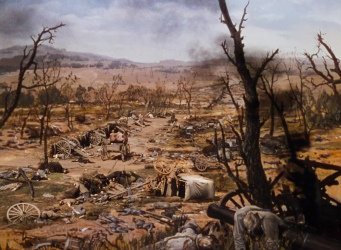 |
| [click on the thumbnail to enlarge] |
In stark contrast is the true heroine of Gone with the Wind, Melanie Wilkes: as forgiving as Scarlett is spiteful, as forthright as Scarlett is scheming, and as frail as Scarlett is strong. Despite it not being the most glamorous of roles, Melanie is in large part the mortar that holds the story together and is certainly the heart of it, and Olivia de Havilland does a marvelous job conveying that warmth and tenderness. The rest of the sprawling supporting cast is no less impressive. Hattie McDaniel took home a well-deserved Academy Award -- the first for an African-American -- for her work here as Mammy. Her brashness and sass are endearing, of course, but Mammy is more of a maternal figure to Scarlett than her own mother. It's argued in one of the extras on this disc that the most intense relationship in the film isn't between Scarlett and Rhett but between Scarlett and Mammy. She may even be the strongest and most reliable of the many dozens of characters in the entire film. A frequent talking point in the extras throughout this set is that Leslie Howard was considered much too old to play the twentysomething Ashley Wilkes, but between the convincing makeup work and his strong performance, that thought had never entered my mind until now. It's not an easy part to play, both gentlemanly and meek...a blank slate onto which Scarlett can project whatever fantasy she happens to have dreamed up and easily manipulated enough that he can be nudged wherever the women in his life insist. The list of smaller but memorable parts seems endless: Thomas Mitchell as Scarlett's Irish immigrant father who instills in her a profound love of the land, Evelyn Keyes as her spoiled, impossibly jealous younger sister, Butterfly McQueen whose squeaked "I don't know nothin' 'bout birthin' babies!" remains one the film's most iconic lines, and Harry Davenport as an ornery doctor are among just a few of note.
The romance between Rhett and Scarlett doesn't overwhelm the bulk of the film, and part of the intrigue is that it doesn't settle into convention. These aren't soulmates whose embraces are punctuated by sweepingly cinematic strings. There's a certain level of repulsion and attraction. Rhett is all too aware that Scarlett will bring him nothing but heartache and frustration, and yet he's unable to turn away. Scarlett clearly finds some comfort in the convenience of a reasonably loyal multimillionaire, but it's never overwhelmingly clear how much more than that, if anything at all, Rhett actually means to her. Her attraction comes in fits and spurts, and the more enthralled she becomes, the more quickly Rhett's interest seems to fade. In a more traditionally constructed screenplay, Gone with the Wind would've ended shortly after where the intermission is here, but the film chooses instead to follow the two lovers well after the Civil War has come to an end. It says quite a bit about the strength of the performances and the richness of these characters that the film remains so compelling even with the more mundane backdrop pervasive throughout its second half.
Although Gone with the Wind's primary interest is undoubtably its characters, the film still serves as a visual spectacle. Its lavish plantations manage to eclipse those that truly existed in the Old South, Scarlett's wardrobe is filled with the stunningly ornate dresses expected of a
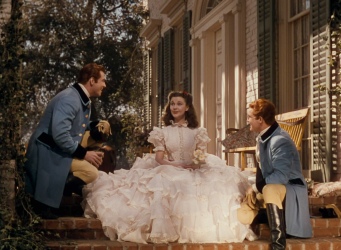 |
| [click on the thumbnail to enlarge] |
Gone with the Wind, at least to my mind, stands on the brink of perfection, but despite its enduring success, it hasn't been beyond criticism. Some have been turned off by the daunting length of the film, particularly in a second half that's so intensely oriented around the relationship between Rhett and Scarlett. I can't argue that the final act of the film doesn't seem somewhat anticlimactic, but it's strictly by comparison, and the strength of the performances and the emotional intensity pervasive throughout these moments largely define Gone with the Wind for me. I can't possibly shrug them off as meandering the way some feel compelled to do. The film has also been criticized for its presentation of slavery. It's certainly true that the black characters throughout Gone with the Wind settle somewhat into cliché, and the institution of slavery is never portrayed as a negative. From a dramatic sense, though, this still works in Gone with the Wind -- Uncle Peter, Big Sam, Prissy, and Mammy are treated more as part of the family -- and I can still appreciate the film while accepting the sometimes unfortunate context of its era.
Gone with the Wind is by any conceivable measure legendary. Its sparkling dialogue, the intriguingly complex relationship between Scarlett and Rhett, a sprawlingly epic scope, a flair that transcends the maudlin or traditionally melodramatic, and its visual spectacle made the film the most colossal success of its era, and Gone with the Wind has yet to be rivaled in the seven decades that have since passed. With its vivacity and emotional impact not having dulled at all over these great many years, Gone with the Wind is a timeless classic in the truest sense of the word.
I continue to be astonished by not just how frequently Warner Bros. is taking advantage of its spectacular catalog of titles but how exceptional their work so frequently is. No other major studio has even approached what Warner has accomplished time and time again. While there have been trickles of classic catalog titles from other studios, either the remastering isn't quite up to par or the selection of films just doesn't manage to impress in quite the same way. I certainly respect that a film like The Diary of Anne Frank is being issued in high definition, but such an announcement as that doesn't coax the same sort of excitement as, say, Casablanca or The Adventures of Robin Hood. This is a studio that, in the space of just a few weeks, has issued the first Hitchcock film on these shores in high definition as well as both Gone with the Wind and The Wizard of Oz. Warner, more than any other major, makes Blu-ray compelling for those of us seeking out more than just the contemporary. Gone with the Wind has been lavished with a truly remarkable release on Blu-ray, from its meticulous 8K remaster to its nearly twenty hours of extras to the velvet-draped box in which this collectors' edition is housed. This is a film that should be considered an essential part of any collection, and although I do have some mild criticisms about the selection of extras, the sheer volume of material just makes this special edition of Gone with the Wind that much more compelling. DVD Talk Collector Series.
Video
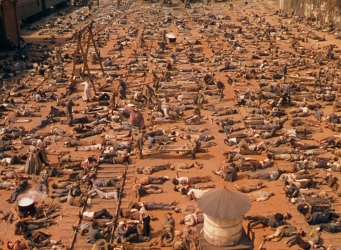 |
| [click on the thumbnail to enlarge] |
There are no discernible flaws at all: no speckling or wear, no excessive filtering or digital noise reduction, no hint of edge haloes, and no stutters in the compression to speak of. The texture of its film grain seems appropriate, certainly not suffering from any signs of being artificially smeared away and faintly visible in the way I'd expect from a vintage Technicolor release. This Blu-ray disc is unwaveringly natural and filmlike just as it should be.
Gone with the Wind is presented on a dual-layer Blu-ray disc, and nothing extraneous has been included on the same disc as the movie to devote as much of the bit budget as possible to its VC-1 encode. The film has been pillarboxed to preserve its original theatrical aspect ratio of 1.37:1.
Audio
Much like The Wizard of Oz before it, this Blu-ray disc features a restored monaural soundtrack for Gone with the Wind along with a Dolby TrueHD 5.1 remix. (Inexplicably, the mono track is hidden under the 'Special Features' menu, the same as it is with Oz.) A background hiss is more pronounced in the monaural soundtrack, and it sounds somewhat harsher by comparison to the lossless remix. That overall cleaner sound is the greatest benefit of the TrueHD track, and it's worth noting that the remix very much stays true to the original sound design. Dialogue is consistently anchored in the center channel, and for the bulk of the film, the surrounds are reserved almost entirely for reinforcing the score. The music, largely by Max Steiner, is rendered effectively. The overall fidelity doesn't transcend the age of the film, but it's clean and reasonably full-bodied, and the same holds true for the dialogue and sound effects. The sound design is at its most aggressive, naturally, during the Civil War sequences. Explosions and cannon fire roar from every direction while also coaxing an appropriate snarl from the subwoofer. Scarlett's epiphany that closes out the film is preceded by swirling voices that also take advantage of the many channels at its disposal. This is precisely what a remix of a classic film ought to be: accentuating the strengths of the original audio without heavyhandedly forcing more modern sensibilities onto it. It's appreciated that this is such a faithful remix, as is the inclusion of the original mono audio.
Gone with the Wind also offers Dolby Digital 5.1 dubs in German, French, Italian, and Spanish. Also included are monaural tracks in Spanish and Portuguese along with an expansive selection of thirteen subtitle streams.
Extras
Warner Bros. is celebrating the seventieth anniversary of Gone with the Wind with this lavish collectors' set. Some nineteen hours of audio commentary, featurettes, documentaries, shorts, trailers, and even a TV movie are spread across this four disc set. As was the case with The Wizard of Oz, certain retailers are stocking their own stripped-down versions -- apparently both one and two disc sets in traditional Blu-ray cases are going to be available shortly -- but by far the most elaborate edition is the boxed set reviewed here. This collectors' edition certainly comes at a price, though, and those who'd prefer a more standard case and are less interested in these printed extras would likely be best served by one of the pared-down releases instead. This really is a spectacular package, although the extras on the discs themselves aren't quite as expansive or diverse as those on The Wizard of Oz.
David O. Selznick was notorious in the industry for his onslaughts of memos, and it's even mentioned in Rudy Behlmer's audio commentary that much of what's known about the film's production is owed to those reams upon reams of notes. Several of them have been reproduced here, including concerns about casting, mulling over who ought to replace Victor Fleming after he was pushed past the breaking point, and celebrating the first footage to have been lensed before principal photography had officially begun. The most intriguing of these is a five page letter from 1937 in which Selznick debates at length the pros and cons of hiring George Cukor as well as a slew of other potential directors for Gone with the Wind, complete with their salaries and availability. The incomplete script, logistical headaches for mounting a project of this scale, and how Gone with the Wind might impact the rest of the Selznick slate are also addressed.
Like The Wizard of Oz before it, this collectors' edition also features a 52 page hardcover book. It too is beautifully designed, featuring a slew of posters from the world over, dozens of production stills and promotional photos, a gallery of behind-the-scenes shots, and even quite a bit of conceptual artwork. This is predominantly a visual piece, and its captions are too brief to distract from the glossy, gorgeous photography and artwork waiting within.
For those seeking out something to read, though, a 20 page reproduction of an original playbill offers brief biographies and even reasonably lengthy retrospectives by both Vivien Leigh and Clark Gable. The highlight is a three page set of production notes that delves into precisely how many feet of film were shot, that a literal translation of the novel would demand right at a full week to unspool, and just how many sketches, costumes, technicians, sets, and even specific types of animals were necessary to bring Gone with the Wind roaring to life. The playbill is also handsomely illustrated and includes lovingly painted renditions of the primary cast.
A sleeve labeled "Art of Gone with the Wind" opens to reveal ten pieces of conceptual artwork for the film's lavish plantation sets. These painted pieces are reproduced on heavy cardstock the size of a large postcard.
Each of these limited editions is individually numbered, and the case is especially striking. The overall construction feels even more robust than The Wizard of Oz' case, and it doesn't expose its seams to damage the way that other box does. The sturdy, lightly embossed cardboard box is draped in red velvet and really does look gorgeous. Though Gone with the Wind is a four disc set, the soundtrack CD sampler is packaged apart from the rest of the discs. The two Blu-ray discs and the double-sided DVD arrive in an impressively thick foldout book, and its height is closer to a DVD case than a traditional Blu-ray set. Also tucked inside are a booklet summarizing the extras along with a series of advertisements, including offers for a Gone with the Wind cuckoo clock and a charm bracelet.
Disc One
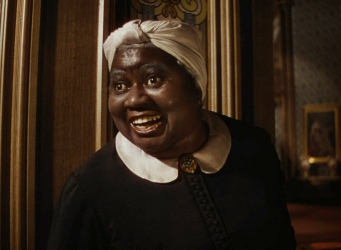 |
| [click on the thumbnail to enlarge] |
As someone who has yet to read the Margaret Mitchell novel, I appreciate that Behlmar takes the time to highlight some of the differences between this adaptation and the printed page: characters that are fused together, material that has been softened to suit the filmgoing audiences of 1939, and other subplots and objectionable moments that are excised entirely. A number of his comments about Mitchell, such as her secretive writing process and her dissatisfaction with the text the introduces the film, aren't addressed anywhere else in the extras on this disc.
Along with speaking about the production of Gone with the Wind, Behlmar also takes care to put the events of the film in a historical context, touching on the accuracies and the inaccuracies alike. Even though his comments had clearly been prepared in advance, Behlmar is personable enough that this commentary never feels as if he's simply reading pages of notes in front of him verbatim. Most every topic that Behlmar addresses is discussed in an impressive level of detail, including notes about the writing and recording of Max Steiner's score, the financial black hole of production, the specifics of various contracts, potentially devastating requests insisted upon by the Production Code, and the indelible impression that Gone with the Wind has left on popular culture. Behlmar is even able to point out which sequences were reshot as the film changed hands from director to director and as dailies failed to match Selznick's vision, and deleted scenes are another favorite topic. His comments about Gone with the Wind's cinematography are particularly intriguing, from Selznick having envisioned an early version of Cinerama for the colossal fire sequence to precisely how the film broke new ground with the use of Technicolor. There are also numerous casting notes, including the names of quite a few of the other actors and actresses considered for the film. Behlmar is somewhat quiet throughout the final half hour, but this last stretch still offers some terrific comments, reflecting on the Southern accents that are and aren't present throughout the film and the abysmal alternate ending that had been unsuccessfully pitched to Selznick.
This audio commentary with Rudy Behlmar is in every way exceptional, and even with the sheer volume of extras spread across this set, this is the most essential of them all.
Disc Two
The majority of the extras for Gone with the Wind are offered on this second Blu-ray disc. Perhaps it's that the sprawling scope of The Wizard of Oz's extras spoiled me, but this second disc seems more limited than I would've preferred to have seen. The bulk of them revolve around the cast, and while it's beyond any argument that Gone with the Wind owes so much of its success to the talent in front of the camera, it seems as if there's so much more that could've been addressed.
For example, The Wizard of Oz included a half-hour featurette entitled "Victor Fleming: Master Craftsman", and although Gone with the Wind is highlighted prominently in that retrospective, it didn't find its way to this Blu-ray set. The only vintage promotional materials are trailers and newsreels, really; no still galleries or radio spots have been included. Although a soundtrack CD sampler is part of this mammoth package, there isn't an
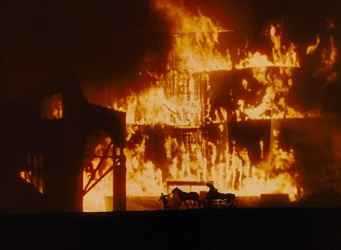 |
| [click on the thumbnail to enlarge] |
I'm absolutely not complaining about any lack of extras; this disc alone features nine hours of material, and the audio commentary and the mammoth When the Lion Roars documentary combine to add another ten hours to that. This is undoubtedly a five-star effort, yet it just seems as if a wider net than this could've been cast, and its more limited scope leaves Gone with the Wind somewhat overshadowed by the exceptionally diverse extras on The Wizard of Oz.
- Making of a Legend: Gone with the Wind (123 min.; SD): The first of the video-based extras in this collectors' edition is the feature-length documentary Making of a Legend from 1988. Perhaps the most intriguing inclusion here is an expansive selection of screentests, most memorably a Technicolor test with Paulette Goddard reading both Scarlett and Mammy. This documentary offers a remarkably thorough look at how the film came together, beginning with background details on David O. Selznick and Margaret Mitchell. After Selznick's initial skepticism made way for explosive enthusiasm, Making of a Legend charts the frenzy over which actress would land the most coveted role in cinema history, a price tag that spiralled wildly out of control during preproduction despite the lack of any meaningful headway, why Selznick opted to partner with MGM even with a more generous offer from Warner on the table, softening the script to appease critics of the novel, and using all seven of the Technicolor cameras in existence while filming the fire on the backlot.
Making of a Legend from there explores some of the challenges of production, including the revolving names on the director's chair, Clark Gable's unsteady footing on the dance floor, and the film's first cinematographer being fired. This documentary sometimes toys with the usual conventions, here dressing up one of the original extras in full costume and makeup while describing one of Gone with the Wind's most iconic shots: Scarlett walking through a field of a thousand wounded soldiers, a mix, as it turns out, of extras and dummies. Making of a Legend also touches on the challenges the film would continue to face in post-production, including composing three hours of music with an impossibly tight deadline, editing without ever having a final script to use as a reference, and the daunting task of completing the extensive visual effects used to convey the scale of this Civil War epic. Of course, we all know how this story ends, and the documentary comes to a close with the film's gala premiere in Atlanta, its incomparable success at the box office, and the armful of statuettes it would go on to take home at the Academy Awards the following year.
Though much of this information is also contained in Rudy Behlmer's audio commentary, the presentation here is still compelling, and if nothing else, Making of a Legend is worth watching for the screentests alone.
- Gone with the Wind: The Legend Lives On (33 min.; SD): "The Legend Lives On" picks up where Making of a Legend leaves off, delving into the legacy and longevity of Gone with the Wind. It notes the presence of actual Confederate soldiers at the film's premiere in Atlanta, its enormous success across the world, and how much of a draw Gone with the Wind has continued to be throughout its many theatrical re-releases. Also featured here are a conversation with Mickey "Baby Beau" Kuhn, how wonderfully Gone with the Wind serves as a time capsule of 1939 despite its period setting, debating that it's not Rhett who has the most intense and powerful relationship with Scarlett in the film, how its continued success prompted a sweeping change in the studios' attitudes towards film preservation, the movie's fiftieth anniversary celebration, and dedicated "Windies" who collect every treasured speck of memorabilia they can unearth and even trek out to the real-life Tara in Ireland.
- 1939: Hollywood's Greatest Year (68 min.; SD): Hollywood
released a particularly dazzling assortment of films to the silver screen in 1939, among them Gunga Din, Stagecoach, Mr. Smith Goes to Washington, The Wizard of Oz, Ninotchka, Goodbye Mr. Chips, The Women, The Roaring Twenties, Dodge City, Dark Victory, Confessions of a Nazi Spy, Son of Frankenstein, Only Angels Have Wings, The Hunchback of Notre Dame, Love Affair, Jesse James, Of Mice and Men, Wuthering Heights, Babes in Arms, and, of course, Gone with the Wind. "Hollywood's Greatest Year" not only explores each of those films but delves into the state of the industry in 1939: the widespread optimism as America began to slink out from the Great Depression, the studio system at its peak, the varying fortunes of the different studios in Hollywood, and how this would prove to be a breakthrough year for Technicolor. The featurette closes by recapping the recipients of the Academy Awards the following year.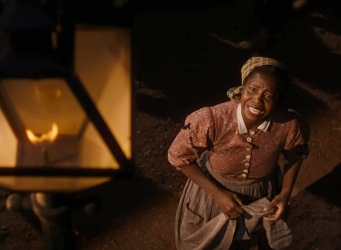
[click on the thumbnail to enlarge]
- Gable: The King Remembered (65 min.; SD): Quite a few of the remaining extras focus on the cast, beginning with this 1975 retrospective hosted and narrated by Peter Lawford. "The King Remembered" certainly looks and feels dated, from its approach to the shoddy condition of the film excerpts scattered throughout. The interviews with Andy Devine, William A. Wellman, Yvonne De Carlo, and Adela Rogers St. Johns are certainly personable, though. It's mentioned, for instance, that Gable exuded arrogant masculinity yet laughed off being called "The King" and didn't even think of himself as a particularly good actor. Among the other topics of conversation here are his initial drive to become an actor as a means to escape poverty, winning an Oscar for a small role he was forced into as "punishment", establishing himself as the top box office draw in the country, the devastating blow of Carole Lombard's untimely death, his military service during WWII, and passing away without ever having a chance to meet his son that would be born just a few months later.
- Vivien Leigh: Scarlett and Beyond (46 min.; SD): Jessica Lange, meanwhile, hosts this 1990 special. It too spans the entire life of its subject, including Leigh's shaky start as an actress, falling for Laurence Olivier despite both of them being married with children, and struggling in the shadow of a husband who was not only a legendary actor but would soon be knighted. Along with the colossal success of Gone with the Wind, "Scarlett and Beyond" touches on her earlier British films as well as more recognizable titles like Waterloo Bridge, Caesar and Cleopatra, and Ship of Fools. It's also noted how deeply Leigh was able to draw from her own troubles for her other standout role, Blanche DuBois in A Streetcar Named Desire.
- Melanie Remembers: Reflections by Olivia de Havilland (39 min.; SD): The retrospectives for Clark Gable and Vivien Leigh were told through the words of others and spanned their entire lives. Olivia de Havilland -- one of just a tiny handful of Gone with the Wind's credited actors still surviving today -- is able to relate her experiences herself, and the conversation never veers away from this film. The still-charming de Havilland opens with a terrific story about being asked to covertly read for the part despite being under contract to Warner Bros., how what she thought was a comical reading wound up completely winning over David O. Selznick and George Cukor, and how she had to turn to Jack Warner's wife to wrangle her way onto the cast. Also discussed here are the many different hairstyles that were tested, a prank she played on Clark Gable while Melanie was bedridden, frowning when she discovered the camera could only accommodate one hoop skirt at a time, and how an unsuccessful plea to keep George Cukor in place made way for an inspired piece of direction by Victor Fleming. de Havilland speaks quite a bit about Vivien Leigh as well, contrasting their very different approaches to getting into character, the toll Leigh's self-imposed manic work schedule took on her, and revisiting with her at the Civil War Centennial premiere in Atlanta. Its more intense focus -- not to mention the presence of the star herself -- makes this by far the best of the cast retrospectives.
- The Supporting Players (30 min.; SD): This collectors' edition of Gone with the Wind doesn't ignore the sprawling supporting cast either, offering mini-featurettes on Thomas Mitchell, Barbara O'Neill, Evelyn Keyes, Ann Rutherford, Hattie McDaniel, Oscar Polk, Butterfly McQueen, Leslie Howard, Rand Brooks, Caroll Nye, Laura Hope Crews, Eddie Anderson, Harry Davenport, Jane Darwell, Ona Munson, and Cammie King. These featurettes are divided into three groups -- "At Tara", "At Twelve Oaks", and "In Atlanta" -- and segmented out further from there. Offered within are brief biographies, filmography overviews, headshots and promotional photos, and excerpts from some of the cast's other work. This set, strangely enough, ends with a brief note about the
enduring vitality of Gone with the Wind that seems misplaced on the Special Features menu.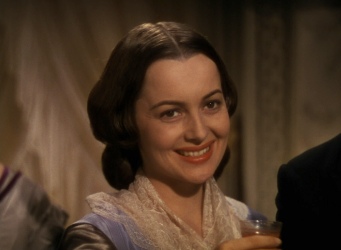
[click on the thumbnail to enlarge]
- Restoring a Legend (18 min.; SD): This featurette explores the 2004 Ultra Resolution remastering rather than the 8K work done for this Blu-ray release, but some of the same concepts certainly still apply. Warner's digital team delves into the background of the Technicolor process as well as how it both helps and hinders the remastering process. Meticulous color correction, manual dirt and scratch removal, edge detection when merging the different records of 3-strip Technicolor, mixing and matching different elements, and dealing with shrinking, warping, and tearing are all discussed here. They also touch on how this approach reveals more detail than has ever been visible before as well as the restoration of the audio.
- Dixie Halls Gone with the Wind (4 min.; SD): The first of two newsreels documents the colossal premiere of Gone with the Wind in Atlanta.
- Atlanta Civil War Centennial (4 min.; SD): The city of Atlanta celebrated the Civil War Centennial with another gala premiere of Gone with the Wind, and David O. Selznick was joined by surviving cast members Olivia de Havilland and Vivien Leigh. Again, this black and white news footage documents the celebration.
- Historical Theatrical Short - The Old South (11 min.; SD): In order to put the backdrop of Gone with the Wind in context for audiences that may have been unfamiliar with The Old South, this short was produced. It's almost completely about the international demand for cotton and how prosperous the South was with the advent of the cotton gin...even though that success was carried on the back of slave labor, prompting opposition from both the North and the British. Some of the dated racial stereotypes are a little cringeworthy, and the insistence that cotton is and will forever be the backbone of the South seems kind of myopic even in 1939. This is still an intriguing inclusion as a historical document, if nothing else.
- Trailers (14 min.; SD): Five trailers for Gone with the Wind span fifty years of releases and reissues.
- International Prologue Explaining The Civil War (1 min.; SD): As the American Civil War wasn't a known quantity to the world at large, international releases featured a prologue to help put the film in
context, and this additional footage has been offered here.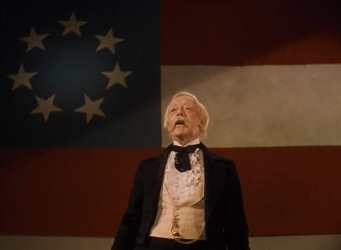
[click on the thumbnail to enlarge]
- Foreign Language Versions (3 min.; SD): Though this sort of extra seems outmoded now that an alternate soundtrack is a click of a button away, this comparison features a French version of Scarlett chatting with a couple of would-be suitors, an Italian version of an early embrace between Rhett and Scarlett, and a German version of their frantic escape from Atlanta.
- Moviola: The Scarlett O'Hara War (97 min.; SD): Just as the collectors' edition of The Wizard of Oz featured a related TV movie, so too does Gone with the Wind. This 1980 movie stars Tony Curtis as David O. Selznick, the movie mogul orchestrating a nationwide search for the most coveted role in Hollywood. The story primarily swirls around Selznick's inability to find a suitable lead, the parade of actresses gunning for the part of Scarlett, and the wheeling and dealing behind the scenes to get Gone with the Wind off the ground. Tallulah Bankhead, Joan Crawford, and Paulette Goddard in particular score quite a bit of the attention, especially the latter who's also seen bickering with her live-in maybe-husband Charlie Chaplin about his lack of clout in Tinseltown. Even though the name "Rhett Butler" isn't anywhere to be found in the title, Moviola also touches on the struggles to cast Clark Gable in the film as well. Strangely, in this take, Vivien Leigh wasn't actively pursuing the role, and she's only hinted at before being briefly glimpsed at the tail end. It's an okay TV movie, but there's an awkward sense of whimsy! that sputters and stutters...everything from the stale oh-oh-he-fell-in-the-swimming-pool gag to a couple of conmen groping would-be actresses in sleazy hotel rooms.
Interestingly, the screenplay for Moviola was penned by William Hanley who would go on to write the Scarlett miniseries. Though this is a standard definition presentation, the transfer's reasonably nice.
Disc Three
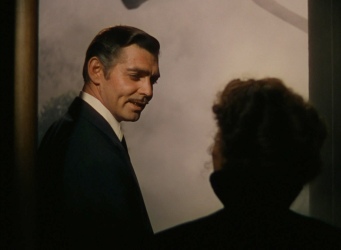 |
| [click on the thumbnail to enlarge] |
"The Lion Reigns Supreme" begins as MGM is still reeling from the untimely death of Thalberg, leaving the studio entirely in the hands of Mayer, then the highest paid man in the nation. Mayer is by far the driving focus of this segment, from his emphasis on wholesome family entertainment to very different reflections on the man by the stars he'd helped foster to an obsession with race horses that essentially left MGM without a steward. "The Lion Reigns Supreme" takes a look at the new slate of actors and actresses to sign with the studio at the peak of its success during WWII as well as how its star was beginning to lose its luster. It's in this segment that Gone with the Wind is featured.
Finally,
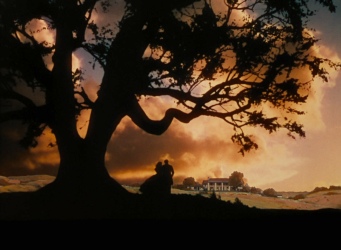 |
| [click on the thumbnail to enlarge] |
When the Lion Roars is, as its daunting runtime suggests, astonishingly thorough. The only topic I would've liked to have seen addressed that isn't touched on at all is MGM's success at animation. Otherwise, few stones are left unturned, aiming its spotlight at key members of the small army of technical talent on-staff at MGM, dozens of the studio's most notable films, and both the producers that steered such a mighty ship and the dazzling roster of talent that propelled it along. The documentary draws from newly-conducted -- as of 1992, at least -- interviews as well as a massive assortment of archival footage, and, of course, excerpts from the many dozens of films highlighted throughout have been included as well. Some of the actors, directors, and producers featured here in interviews new and old are Katharine Hepburn, Mickey Rooney, Roddy McDowall, Cyd Charisse, Debbie Reynolds, June Allyson, Margaret Sullivan, Van Johnson, Ricardo Montalban, Groucho Marx, Charlton Heston, Gene Kelly, Joan Crawford, John Huston, David Lean, Judy Garland, Johnny Weissmuller, Richard Brooks, and Samuel Marx. Its sights are also aimed at Norma Shearer, John Gilbert, Erich von Stroheim, Lon Chaney, Greta Garbo, Clark Gable, Lionel Barrymore, Maureen O'Sullivan, Jean Harlow, Spencer Tracy, Vivien Leigh, Lana Turner, Hedy Lamarr, Buster Keaton, and Elizabeth Taylor, among quite a number of others. When the Lion Roars is a marvelous tribute to MGM and the tumult that brought about some of the most exceptional films in the history of cinema, and I'm thrilled that it's been included as part of this boxed set. It's worth noting that this same disc has been included with The Wizard of Oz' collectors' set, though, and that could dull the enthusiasm of viewers interested in seeking out both.
Disc Four
Finally, a soundtrack CD sampler features eight of the most memorable cues from the film and runs just shy of 34 minutes in length.
The Final Word
As adept with intimate drama as it is with the sprawlingly epic scope of the death of the Old South, few films have endured as Gone with the Wind has over the past seventy years. This is a film that continues to be so wholly captivating that its four hour runtime seems perhaps half that, and its popularity and influence cannot be overstated. It's almost impossible to conceive of an epic melodrama with characters this engaging, such a terrific balance of heartbreak and sparkling wit, and startlingly beautiful imagery. Gone with the Wind is not above criticism, and there have long been debates as to whether or not it deserves to be called a masterpiece, but I'm much too enthralled to pay much notice to that.
More than any of the other major studios, Warner Bros. continues to impress with its spectacular presentations of its most beloved films on Blu-ray, and it's startling to think that in the span of just a month and a half, Gone with the Wind, North by Northwest, and The Wizard of Oz have all found their way onto the format in such world-class releases. Gone with the Wind is nothing short of dazzling in high definition, and even for those who've picked up any of the DVD releases that have come and gone over the years ought to find the film well-worth rediscovering on Blu-ray. Though this release still strikes me as somewhat less definitive than The Wizard of Oz, it's difficult to feel as if Gone with the Wind has gotten any sort of short thrift with this collectors' set, boasting nearly twenty hours of extras in an eyecatching boxed set. It's for truly exceptional releases such as this that DVD Talk established its Collectors' Series label, and so it follows: DVD Talk Collectors Series.
Additional Screenshots
|
| Popular Reviews |
| Sponsored Links |
|
|
| Sponsored Links |
|
|
| Release List | Reviews | Shop | Newsletter | Forum | DVD Giveaways | Blu-Ray | Advertise |
|
Copyright 2024 DVDTalk.com All Rights Reserved. Legal Info, Privacy Policy, Terms of Use,
Manage Preferences,
Your Privacy Choices | |||||||









